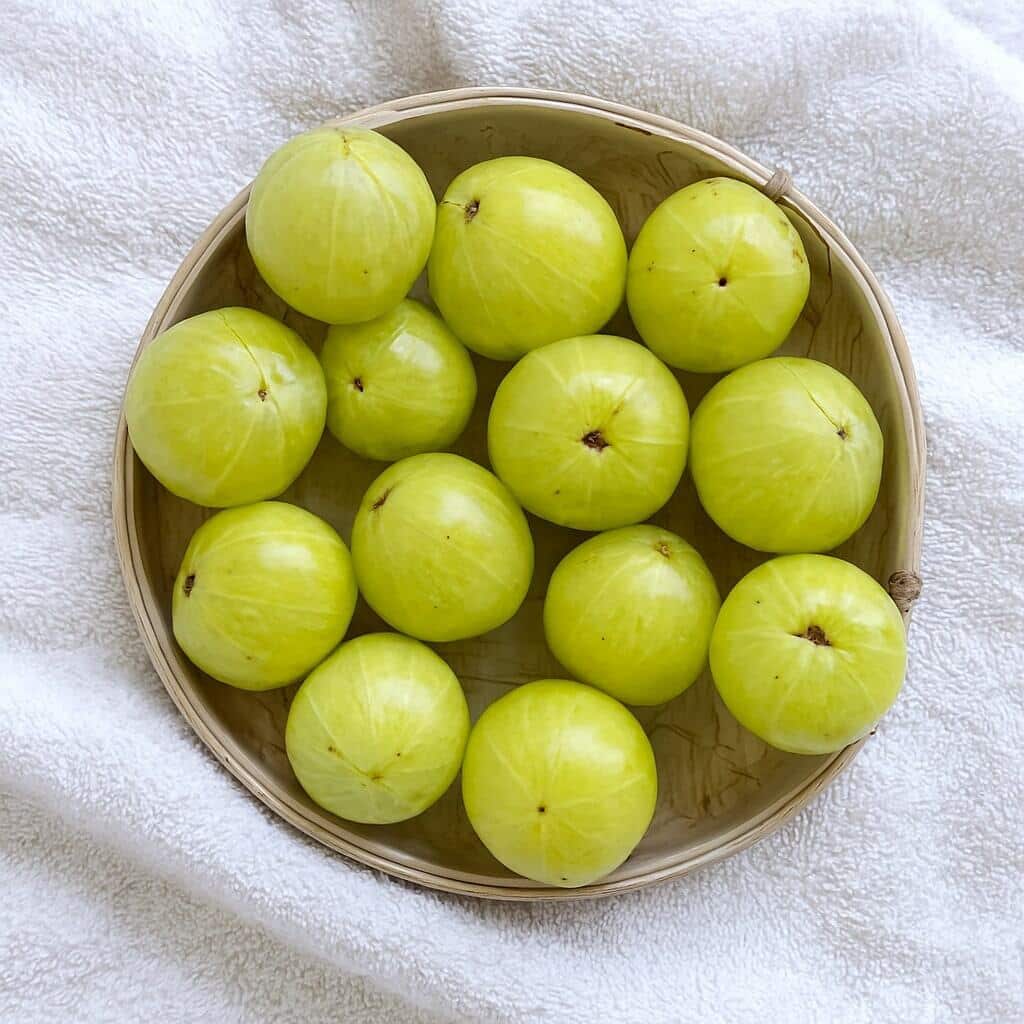Amla Benefits: Complete Guide to Indian Gooseberry & How to Preserve It for 1 Year
Amla Benefits: 15 Health Benefits of Indian Gooseberry + Preservation Guide (2025)

What is Amla? Understanding the Indian Superfruit
Amla, scientifically known as Phyllanthus emblica and commonly called Indian gooseberry, is a small green fruit that has been a cornerstone of Ayurvedic medicine for over 5,000 years. This winter superfruit grows abundantly across India and is now gaining global recognition as one of nature’s most potent health foods. With its characteristic sour taste and remarkable nutritional profile, amla deserves its reputation as a true wellness powerhouse.
Amla Nutritional Value: What Makes It a Superfood?
Understanding amla’s nutritional composition helps explain its extraordinary health benefits. A single 100-gram serving of fresh amla contains approximately 445 milligrams of vitamin C, which is nearly 10 times more than an orange. This makes amla one of the richest natural sources of ascorbic acid available.
Beyond vitamin C, amla provides essential minerals including calcium, iron, phosphorus, and chromium. The fruit is rich in antioxidants like polyphenols, flavonoids, and tannins that protect cells from oxidative damage. Amla also contains healthy amounts of dietary fiber, protein, and essential amino acids, creating a complete nutritional package in every bite.
15 Science-Backed Amla Benefits for Your Health
Boosts Immune System Naturally
The exceptional vitamin C content in amla significantly strengthens immune function by stimulating white blood cell production. Regular consumption of amla can help your body fight infections more effectively, particularly during seasonal changes when immunity tends to dip. The antioxidants work alongside vitamin C to create a robust defense system against pathogens.
Improves Digestive Health and Metabolism
Amla acts as a natural digestive tonic that stimulates gastric juice secretion and improves nutrient absorption. The high fiber content promotes healthy bowel movements and prevents constipation. For those dealing with acidity or indigestion, amla’s alkaline nature helps balance stomach pH levels naturally.
Supports Heart Health and Cholesterol Management
Research suggests that regular amla consumption may help reduce bad cholesterol (LDL) levels while increasing good cholesterol (HDL). The chromium content helps strengthen blood vessels and may reduce the risk of atherosclerosis. Amla’s anti-inflammatory properties also support overall cardiovascular function.
Regulates Blood Sugar Levels
Studies have shown that amla can improve insulin sensitivity and help manage blood glucose levels, making it beneficial for people with diabetes or prediabetes. The chromium in amla aids in carbohydrate metabolism and helps maintain stable blood sugar throughout the day.
Enhances Skin Health and Anti-Aging
The vitamin C and antioxidants in amla stimulate collagen production, leading to firmer, more youthful-looking skin. Regular consumption can help reduce fine lines, wrinkles, and age spots. Amla’s anti-inflammatory properties also help combat acne and skin inflammation.
Promotes Hair Growth and Prevents Premature Graying
Amla has been used in traditional hair care for centuries. It strengthens hair follicles, reduces hair fall, and may slow down premature graying by providing essential nutrients to hair roots. The vitamin C improves scalp circulation, promoting healthy hair growth.
Supports Liver Detoxification
Amla aids liver function by promoting the elimination of toxins from the body. Its hepatoprotective properties help protect liver cells from damage caused by medications, alcohol, or environmental toxins.
Improves Eye Health and Vision
The carotenoids and vitamin A in amla support eye health and may help prevent age-related macular degeneration and cataracts. Regular consumption can also help reduce eye strain and improve overall vision.
Strengthens Bones and Prevents Osteoporosis
The calcium content in amla, combined with its ability to enhance calcium absorption, makes it beneficial for bone health. It may help prevent osteoporosis and maintain bone density as you age.
Enhances Brain Function and Memory
Amla’s antioxidants protect brain cells from oxidative stress and may improve cognitive function, concentration, and memory. Some studies suggest it may also help protect against neurodegenerative diseases.
Reduces Inflammation Throughout the Body
The powerful anti-inflammatory compounds in amla can help reduce chronic inflammation, which is linked to numerous health conditions including arthritis, heart disease, and autoimmune disorders.
Supports Weight Management
Amla boosts metabolism and improves protein synthesis, which can aid in healthy weight management. Its fiber content also promotes satiety, helping control appetite naturally.
Improves Respiratory Health
Amla’s anti-inflammatory and antimicrobial properties make it beneficial for respiratory health. It can help alleviate symptoms of asthma, bronchitis, and other respiratory conditions.
Balances Hormones Naturally
For women, amla can help regulate menstrual cycles and ease symptoms of PMS and menopause. Its adaptogenic properties help the body manage stress hormones more effectively.
Provides Anti-Cancer Properties
While more research is needed, preliminary studies suggest that the antioxidants in amla may have anti-cancer properties and could help prevent the growth of certain cancer cells.
When is Amla Season? Understanding Availability
Fresh amla is primarily available during winter months, typically from November through February in India. This seasonal limitation makes preservation crucial for those who want to enjoy amla benefits year-round.
How to Preserve Amla: The Easiest No-Oil Method
Learning how to preserve amla at home ensures you can access this superfruit’s benefits throughout the entire year. This traditional turmeric and pink salt preservation method is simple, effective, and maintains maximum nutritional value.
Ingredients Needed for Amla Preservation
- Fresh amla (Indian gooseberries) – 1 kg
- Water – 1 liter
- Turmeric powder – 2 tablespoons
- Pink Himalayan salt – 1 tablespoon
- Clean glass jar with airtight lid

Step-by-Step Amla Preservation Process
Step 1: Select and Clean Choose firm, unblemished amlas without soft spots. Wash them thoroughly under running water to remove any dirt or pesticide residue. This ensures your preserved amla stays fresh and safe.
Step 2: Dry Completely Pat the amlas dry with a clean kitchen towel. Ensure no moisture remains on the surface, as water can cause spoilage during storage. Allow them to air dry for 30 minutes if needed.
Step 3: Make Slits Using a clean knife, make three to four vertical slits in each amla, cutting from top to bottom. Don’t cut all the way through – the fruit should remain intact. These slits allow the preservation brine to penetrate while keeping the structure whole.
Step 4: Prepare the Jar Place the slit amlas in a sterilized glass jar, filling it about three-quarters full. Leave some space at the top for the brine. Glass jars work best as they don’t react with acidic foods.
Step 5: Make the Turmeric-Salt Brine Bring one liter of water to a rolling boil. Add two tablespoons of turmeric powder and one tablespoon of pink Himalayan salt. Stir well and let it boil for one minute. The turmeric provides antimicrobial properties while the salt acts as a natural preservative.
Step 6: Pour and Cool Carefully pour the hot turmeric-salt water over the amlas, ensuring all fruits are completely submerged. Leave about an inch of space at the top. Allow the jar to cool to room temperature with the lid slightly open.
Step 7: Seal and Store Once completely cooled, seal the jar tightly. Store in a cool, dark place like a pantry. The preserved amla can last up to 12 months when stored properly.
How to Use Preserved Amla Daily
Consume one preserved amla piece daily on an empty stomach for maximum benefits. You can also chop it and add to smoothies, make chutneys, or use in cooking. The preservation liquid itself becomes nutrient-rich and can be consumed as a wellness shot.
Amla Side Effects: Important Precautions
While amla is generally safe, some people may experience side effects. Consuming excessive amounts can cause digestive upset or diarrhea. People on blood-thinning medications should consult their doctor before regular amla consumption. Pregnant or breastfeeding women should also seek medical advice before adding amla supplements to their routine.
Frequently Asked Questions About Amla
Q: How much amla should I eat daily? A: One to two fresh amlas or one preserved piece daily is ideal for most people. Start with smaller amounts if you’re new to amla.
Q: Can I preserve amla without salt? A: Salt acts as a crucial preservative. However, you can reduce the amount if concerned about sodium intake. The preservation period may be shorter.
Q: Does preserved amla lose its vitamin C? A: Some vitamin C is lost during preservation, but amla retains significant amounts due to its unique composition. The other nutrients and antioxidants remain largely intact.
Q: Can diabetics consume preserved amla? A: Yes, amla is beneficial for blood sugar management. However, diabetics should monitor their response and consult their healthcare provider.
Q: What’s the best time to eat amla? A: Morning on an empty stomach is ideal for maximum absorption. Wait 30 minutes before eating breakfast.
Q: Can children eat preserved amla? A: Yes, children above 5 years can consume amla in small amounts. Start with a quarter piece and adjust based on their tolerance.
Conclusion: Embrace Year-Round Wellness with Amla
Amla stands as a testament to nature’s healing power, offering comprehensive health benefits backed by both ancient wisdom and modern science. From boosting immunity and supporting digestion to enhancing skin and hair health, this humble green fruit delivers remarkable results. By learning to preserve amla using the simple turmeric-salt method, you ensure continuous access to these benefits throughout the year, regardless of seasonal availability.
Whether you’re seeking natural immunity support, better metabolic health, or enhanced beauty from within, incorporating amla into your daily routine provides a simple yet powerful wellness solution. Start preserving amla this winter season and give yourself the gift of year-round health.




